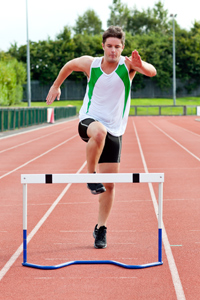Physical activity results in a certain amount of break down and buildup of tissue.
Overuse or chronic injury develops when the break down occurs more rapidly resulting in micro-trauma to the ligaments, tendons, bones and muscles. Staying healthy during a long sports season can be a challenge, especially for multiple-sport athletes who receive little rest between seasons.
Fifty percent of young athletes seen in sports clinics have injuries that are chronic. Common lower body chronic injuries include runner's knee, jumper's knee, shin splints and Achilles tendonitis (heel pain).
 Following these guidelines may help prevent overuse injury:
Following these guidelines may help prevent overuse injury:
- Engage in no more than 16 to 20 hours per week of vigorous exercise
- Include strength, flexibility and endurance exercises in your fitness program
- Take at least one to two days off a week from competition and practice
- Increase training intensity, load, time and distance only per week, and allow adequate adaption to avoid injury
- Decrease load, intensity, time and distance if performance is diminishing because of pain. If you usually run 30 miles a week then run 15 miles a week and see how that feels.
Each workout or practice session can make a difference in preventing chronic injury. These tips can help you stay healthy throughout the season:
-
Warm up: A light pace is recommended for 10 minutes. Jogging or any other activity before play will allow for proper blood flow to the skeletal muscles.
-
Cool down: After practice and competition jog or walk for five to 10 minutes to help prevent muscle soreness.
-
Stretching: Simple static (sit and hold) stretching to the major muscle groups will help increase range of motion. Hold each muscle for 30 seconds, three times. Stretching should be performed after your initial warm-up and cool down to help relieve muscle tightness and soreness.
-
Strengthening: Talk to your athletic trainer about key exercises to help improve deficiencies.
-
Icing: Ice for 20-30 minutes after practices and games to help relieve general soreness.
-
Playing surface: Consistently running on hard surfaces can be punishing on the body. Include alternative methods of conditioning like biking, swimming or the elliptical machine.
-
Proper footwear: Take the time to inspect your shoes to make sure they are not overly worn. Consider investing in proper insoles especially if you have flat feet.
Wear and tear can occur at any age. If the pain does not go away after the first two days, talk with your athletic trainer. The sooner you are treated for a chronic injury, the sooner you can return to activity.
Share comments or questions on this information email: sports.medicine@marshfieldclinic.org.
